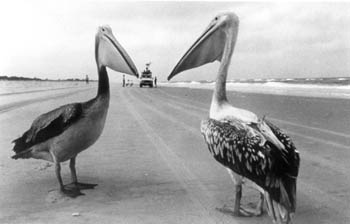![[Metroactive Movies]](http://metroactive.com/movies/gifs/movies468.gif)
[ Movies Index | Show Times | Silicon Valley | Metroactive Home | Archives ]
Double Bills: Two African white pelicans take a flight break in 'Winged Migration.'
Fly Away
The secret life of birds is revealed in Jacques Perrin's 'Winged Migration'
By Richard von Busack
DO THOSE who consider themselves free think much about birds? It may only be after time stuck in a classroom, an office, or a prison, that someone watches them seriously. There are enough indoor types to make Winged Migration a success, let alone the more dedicated ornithologists who seek out birds in the wild. This documentary, by the maker of the bug-epic Microcosmos (kind of a live-action version of Pixar's A Bug's Life) follows five years' worth of bird migrations around the world. European turtledoves, jungle macaws, booming sage grouses in Idaho, Vietnamese black-headed ibexes: these and several dozen other species are observed, following the curve of the globe in the search of food and warmth.
Winged Migration was one of the most popular films at the recent San Francisco International Film Festival. Winged producer Jacques Perrin is a distinguished but unpretentious Frenchman in late middle age. Perrin sees the risk of his films--including 2001's Himalaya--as continuing the challenges of his first important behind-the-camera venture: producing Costa-Gavras' Z. After that success, Perrin had wanted to try something new: "When I went to the financiers and said I wanted to make a movie about insects, they said, 'Don't tell us that!'"
Microcosmos was a more difficult film to make than Winged Migration, Perrin insists, outlining the problem of filming a 3 mm bug for the purposes of 35 mm film. The miniscule movement of such a camera tracking shot required counterweighting the equipment with more than 1,000 pounds of ballast. Perrin also worried about what he called "the comportment of the insects": their biological calendar. If a species of insect emerged between June 27 and 29 annually, the filmmakers had to be ready.
It's hard to imagine a more difficult shoot than Winged Migration, no matter what Perrin says. This film credits 14 cinematographers, and required the construction of various ultralight planes and drones, so the camera could infiltrate a chevron of geese flying through the sky. Surprisingly, no fatalities took place. Perrin counts seven crash landings, but all of them survivable: "One of the cameramen broke a leg, but nothing really important."
Winged Migration captures birds in flight from above, beside and behind. Soon, the viewer's so captivated, he's forgotten how the shots were achieved. The steadiness of the beating wings gives a sense of the rhythm of flying, as well as close-ups of the birds' unruffled faces. Neither the sometimes-redundant narration nor the synthetic-pop soundtrack can seriously interfere with the mood. Even Perrin's IMAX-y insistence on landmarks ends up appropriate. Perrin and his crew use it for counterpoint. We see Canadian geese prowling a ruined car, searching for a drink of polluted water from a dripping radiator, with Monument Valley in the background. Ducks in flight follow the course of the river Seine, as they have for as long as there have been ducks. Understandably they're oblivious to the city of Paris.
Aiming for a narrative thread, Perrin and his crew made up a stunt goose with a piece of fish netting around its leg, so that we can see one particular bird opening and closing the film. The crew had helped a wounded goose, which had just such an injury. Perrin guesses Winged Migration's ratio as 50 percent trained, imprinted birds vs. 50 percent wild birds. Some will be glad for the fabrication, in a distressing episode at a polluted eastern European factory. A red-breasted goose wanders into a puddle of crude oil, and you can't believe the cameramen didn't just drop the camera and shoo the bird away: objectivity only goes so far. Perrin explained that this sequence was an insert, contrived in a studio, with a pool of milk and vegetable dye. After the horrific oil spill in Normandy, where he lives, Perrin had originally planned to document oil-fouled seabirds. Then he forbore, because the images were too painful. Thus the film's most really painful sequence, unfaked, is of ducks shot out of the sky by Midwestern hunters.
You could take a hard-nosed stand that the film impresses a human view on these creatures. Watching Winged Migration, you fight a childish response of some birds as ugly (an arctic raptor called the Auk, preying on baby chicks) and some as cute--the white storks grooming each other and clattering their beaks).
Perrin insists the migration itself is the subject of the film. "Their territory is the planet, not a country. They know no frontiers. That is why they're the symbol of freedom."
[ Silicon Valley | Metroactive Home | Archives ]
Copyright © Metro Publishing Inc. Metroactive is affiliated with the Boulevards Network.
For more information about the San Jose/Silicon Valley area, visit sanjose.com.
![]()

Photograph by Renan Marzin
Winged Migration (G, 85 min), directed by Jacques Perrin, Jacques Cluzaud and Michel Debats, co-written by Perrin and Stephane Durand, photographed by Michael Benjamin, Sylvie Carcedo-Dreujou, Laurent Charbonnier, Luc Drion, Laurent Fleutot, Philippe Garguil, Domique Gentil, Bernard Lutic, Thierry Machado, Stephane Martin, Fabrice Moindrot, Ernest Sasse, Michael Terrasse, Thierry Thomas, edited by Marie-Josephe Yoyotte and with music by Bruno Coulais, opens Friday at Camera 7 in San Jose.
Send a letter to the editor about this story to letters@metronews.com.
From the May 15-21, 2003 issue of Metro, Silicon Valley's Weekly Newspaper.